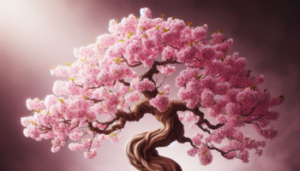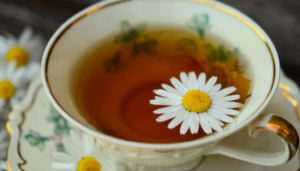
Imagine a miniature world where delicate pink blooms erupt from a gnarled, ancient-looking tree. This isn’t a scene from a fantasy novel, but the reality of owning a cherry blossom bonsai. These captivating trees, with their cascade of flowers and compact forms, are living works of art that require dedicated care. But fear not, aspiring bonsai masters! This detailed care guide will equip you with the knowledge to nurture your miniature cherry tree to its full potential.
1.1 What is Cherry Blossom Bonsai?
Cherry Blossom Bonsai is a miniature version of the iconic cherry blossom trees that bloom in spring. These delicate and beautiful trees can be grown and nurtured in small pots, allowing you to enjoy their captivating blooms within the confines of your own home or garden.
1.2 Why Choose Cherry Blossom Bonsai?
Choosing Cherry Blossom Bonsai is like inviting a touch of Japan into your life. These bonsai trees not only offer stunning beauty, but also symbolize grace, elegance, and the fleeting nature of life. They are a constant reminder to appreciate nature’s fleeting moments and find beauty in simplicity.
1.3 Understanding the Basics of Bonsai Care
Bonsai care involves more than just watering and pruning. It’s about creating the perfect environment for your miniature tree to thrive. Understanding the basics of bonsai care, such as proper watering, fertilizing, and choosing the right soil, will ensure the longevity and health of your Cherry Blossom Bonsai.
2. Choosing the Right Cherry Blossom Bonsai Tree
2.1 Different Varieties of Cherry Blossom Bonsai
There are several varieties of cherry blossom bonsai, each with its own unique characteristics. Some popular varieties include the Yoshino cherry, Kwanzan cherry, and Weeping cherry. Understanding the traits of different varieties will help you choose the one that best suits your preferences and care capabilities.
2.2 Factors to Consider when Selecting a Cherry Blossom Bonsai Tree
Choosing the right cherry blossom bonsai tree involves considering factors such as size, age, style, and overall health. Assessing these factors will help you find a tree that matches your aesthetic preferences and fits well into your care routine.
2.3 Evaluating the Health and Quality of a Bonsai Tree
When selecting a cherry blossom bonsai, it’s crucial to evaluate its health and quality. Look out for signs of disease or pests, inspect the foliage and branches for any damage, and consider the overall balance and proportion of the tree. A healthy and well-maintained bonsai tree will have a better chance of thriving under your care.
Lighting Up Your Bonsai Life:
Cherry blossoms crave sunlight, but just like Goldilocks’ porridge, it needs to be “just right.” Partial sun, with dappled morning and evening light, is ideal. Harsh afternoon sun can scorch leaves and blooms, so consider providing shade during peak hours. Remember, during winter dormancy, cooler temperatures and less light are preferred.
Watering Wisdom:
Think of your bonsai as a thirsty traveler in a desert. Don’t let it dry out! Moist soil is key, but avoid waterlogging. A good rule of thumb: stick your finger into the soil. If it’s dry up to your first knuckle, give it a thorough drink until water trickles through the drainage holes. Watering frequency will vary depending on season and temperature, so adjust accordingly.
Feeding Your Miniature Masterpiece:
Cherry blossoms require regular feeding during the growing season. Choose a bona fide bonsai fertilizer, diluted as per instructions, and apply it monthly as a liquid or pellet. In the winter, however, let your tree rest; hold off on fertilizer during dormancy.
Potting and Repotting:
Bonsai live in tight quarters, mimicking their natural mountainside habitat. Use a shallow bonsai pot with good drainage holes and a specialized bonsai soil mix that allows for airflow and water retention. Repotting is needed every 2-3 years for younger trees, less often for mature ones. Late winter, before flowering, is the perfect time.
Pruning with Precision:
Pruning shapes your bonsai and encourages blooming. Use sharp, sterilized tools to pinch new growth and remove unwanted branches. Remember, less is often more when it comes to pruning cherry blossoms. For major branch removal, consult an experienced bonsai artist.
Winter Wonderland:
Don’t forget, even miniature trees get chilly! During winter, provide your bonsai with a cool (but frost-free) location with plenty of light. Reduce watering and avoid fertilizing. This dormancy period is crucial for healthy growth and future blooms.
Bonus Tips for Blossom Bliss:
- Humidity is your friend: Mist your bonsai regularly, especially during hot days.
- Pests and diseases: Keep an eye out for common bonsai threats and treat them promptly with organic methods whenever possible.
- Talk to your tree: While it may seem strange, spending time with your bonsai, observing its changes, and providing gentle care can build a connection that enhances your bonsai journey.
Mastering the Miniature Oasis:
The core principles outlined in the previous post will establish a solid foundation for your cherry blossom bonsai’s health and happiness. But for those yearning to delve deeper, here are some advanced tips to refine your bonsai artistry:
Fine-Tuning Your Technique:
- Refine Branching: Prune strategically to create layers and asymmetry, mimicking the natural flow of mature trees. Learn about techniques like jin (deadwood) and shari (exposed bark) to add character and depth.
- Root Work: During repotting, gently expose and sculpt the roots to enhance the tree’s character and stability. This requires careful technique and understanding of root functions.
- Wiring Wonders: Use thin wires to gently bend branches into your desired shape. Remember, patience and gradual adjustments are key to avoid damaging the tree.
Secrets of the Blooming Season:
- Flower Power: Pruning just after flowering encourages bud development for the following year. Learn about specific techniques like pinching and bud selection to maximize future blooms.
- Color Alchemy: Certain varieties of cherry blossoms respond to specific soil pH levels, allowing you to influence the intensity of their color. Research your specific cultivar and experiment cautiously.
- Bonsai Bonanza: Consider showcasing your blooming masterpiece in competitions or exhibitions. Sharing your passion and learning from fellow bonsai enthusiasts is a rewarding experience.
Embracing the Holistic Approach:
- Seasonal Cycles: Observe and understand the natural rhythms of your bonsai throughout the year. Adjust your care practices accordingly, respecting its needs during periods of growth, dormancy, and blooming.
- Location, Location, Location: Experiment with different outdoor locations throughout the year, providing the optimal balance of sunlight, air circulation, and protection from harsh elements.
- Inner Harmony: Beyond technique, develop a deep connection with your bonsai. Observe its subtle changes, respond to its needs intuitively, and let your creativity flourish alongside your tiny tree.
Remember, the journey of a cherry blossom bonsai is a marathon, not a sprint. Embrace the learning process, celebrate small victories, and be patient with yourself and your miniature masterpiece. With dedication and a dash of artistry, you’ll witness the breathtaking transformation of your tiny tree into a living testament to your bonsai care mastery.
So, dive deeper, explore the nuances, and let your passion for cherry blossom bonsai blossom into something truly extraordinary!
FAQ
1. How often should I water my Cherry Blossom Bonsai?
Proper watering is crucial for the health of your Cherry Blossom Bonsai. The frequency of watering depends on various factors such as the size of the tree, the type of soil, and the climate. As a general rule, it is recommended to check the moisture level of the soil regularly and water when the top layer feels slightly dry. Avoid overwatering, which can lead to root rot, and ensure proper drainage to prevent waterlogged soil.
2. Do Cherry Blossom Bonsai trees require special fertilizers?
Cherry Blossom Bonsai trees benefit from regular fertilization during the growing season to promote healthy growth and vibrant blooms. You can use specialized bonsai fertilizers or balanced slow-release fertilizers, following the recommended dosage instructions. It is essential to choose a fertilizer with the appropriate balance of nutrients to support the specific needs of your Cherry Blossom Bonsai.
3. How do I prune and shape my Cherry Blossom Bonsai?
Pruning and shaping are vital aspects of Cherry Blossom Bonsai care to maintain the desired size, shape, and aesthetics of the tree. Start by removing any dead, damaged, or overgrown branches. Then, carefully trim back new growth to maintain the desired shape. Wiring can also be used to guide the branches into the desired position. It is crucial to proceed with caution, using sharp and clean tools, and to understand the specific pruning requirements for Cherry Blossom Bonsai trees.
4. What are the common pests and diseases that affect Cherry Blossom Bonsai?
Cherry Blossom Bonsai trees can be susceptible to various pests and diseases, including aphids, spider mites, scale insects, and fungal infections. Regular inspection is essential to detect any signs of infestation or disease early on. Take preventive measures such as maintaining good hygiene, providing proper air circulation, and using organic pest control methods when necessary. If you notice any issues, promptly address them with appropriate treatments to protect the health of your Cherry Blossom Bonsai.

Unveiling the Cherry Blossom Bonsai Care Guide
Imagine a miniature world where delicate pink blooms erupt from…

How to Use Chamomile Tea to Prevent House Plant Diseases
Hello plant enthusiasts! Today, we’re diving into the world of…

